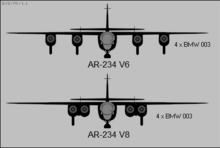From Wikipedia"
The Arado Ar 234 was the world's first operational jet-powered bomber, built by the German Arado company in the closing stages of World War II. Produced in very limited numbers, it was used almost entirely in the reconnaissance role, but in its few uses as a bomber it proved to be nearly impossible to intercept. It was the last Luftwaffe aircraft to fly over Britain during the war, in April 1945.
In late 1940, the Reich Air Ministry (German: Reichsluftfahrtministerium, abbreviated RLM) offered a tender for a jet-powered high-speed reconnaissance aircraft with a range of 2,156 km (1,340 mi). Arado was the only company to respond, offering their E.370 project, led by Professor Walter Blume. This was a high-wing conventional-looking design with a Junkers Jumo 004 engine under each wing.
Arado estimated a maximum speed of 780 km/h (480 mph) at 6,000 m (20,000 ft), an operating altitude of 11,000 m (36,000 ft) and a range of 1,995 km (1,240 mi). The range was short of the RLM request, but they liked the design and ordered two prototypes as the Ar 234. These were largely complete before the end of 1941, but the Jumo 004 engines were not ready, and would not be ready until February 1943. When they did arrive they were considered unreliable by Junkers for in-flight use and were cleared for static and taxi tests only. Flight-qualified engines were finally delivered, and the Ar 234 V1 made its first flight on 15 June 1943 at Rheine Airfield.
By September, four prototypes were flying. The second prototype, Arado Ar 234 V2, crashed on 2 October 1943 at Rheine near Münster after suffering a fire in its port wing, failure of both engines and various instrumentation failures. The aircraft dived into the ground from 1,200 m (3,900 ft), killing pilot Flugkapitän Selle. The eight prototype aircraft were fitted with the original arrangement of trolley-and-skid landing gear, intended for the planned operational, but never-produced Ar 234A version.
The sixth and eighth of the series were powered with four BMW 003 jet engines instead of two Jumo 004s, the sixth having four engines housed in individual nacelles, and the eighth flown with two pairs of BMW 003s installed within "twinned" nacelles underneath either wing. These were the first four-engine jet aircraft to fly. The Ar 234 V7 prototype made history on 2 August 1944 as the first jet aircraft ever to fly a reconnaissance mission, flown by Erich Sommer.
The projected weight for the aircraft was approximately 8 tonnes (7.9 long tons; 8.8 short tons). In order to reduce the weight of the aircraft and maximize the internal fuel, Arado did not use the typical retractable landing gear; instead, the aircraft was to take off from a jettisonable three-wheeled, nosegear-style trolley and land on three retractable skids, one under the central section of the fuselage, and one under each engine nacelle. However, as with the operational Messerschmitt Me 163B rocket fighter which used a landing skid, it was discovered that such a skid-format landing gear for the Ar 234A design's prototypes did not allow post-landing mobility after the end of the landing run, which would have left aircraft scattered widely over an airfield's acreage, unable to taxi off the runway on their own without remounting each and every aircraft on a trolley for towing off the landing area. Erich Sommer himself once noted for late 20th-century television that the landing skid-equipped prototypes, when touching down on a wet-turf airstrip, had a landing run characteristic that "was like greased lightning" and "like [landing on] soap", from the complete lack of braking capability of the landing skid system.
The Ar 234C was equipped with four BMW 003A engines, mounted in a pair of twin-engine nacelles based on those from the eighth Ar 234 prototype. The primary reason for this switch was to free up Junkers Jumo 004s for use by the Me 262, but the change improved overall thrust, especially in takeoff and climb-to-altitude performance. An improved cockpit design, with a slightly bulged outline for the upper contour integrating a swept-back fairing for the periscope, also used a much-simplified window design with far fewer glazing panels (8 in total), than the total of 13 separate glazing panels of the Ar 234B cockpit for ease of production. Airspeed was found to be about 20% higher than the B series and the faster climb to altitude meant more efficient flight and increased range.
Although Hauptmann Diether Lukesch was preparing to form an operational test squadron, only 14 C-series airframes had been completed by the war's end, and of that number fewer than half had been fitted with engines, with a few of them found at the end of the war sitting out in the open, otherwise complete but with empty engine nacelles. Comprehensive flight testing of the new sub-type had yet to begin when Germany surrendered. Three basic variants of the C-series were planned for initial construction, with several more laid out as detailed proposals. Some of these would have had different powerplants, while others were intended to feature swept or "crescent"-type wings.








No comments:
Post a Comment